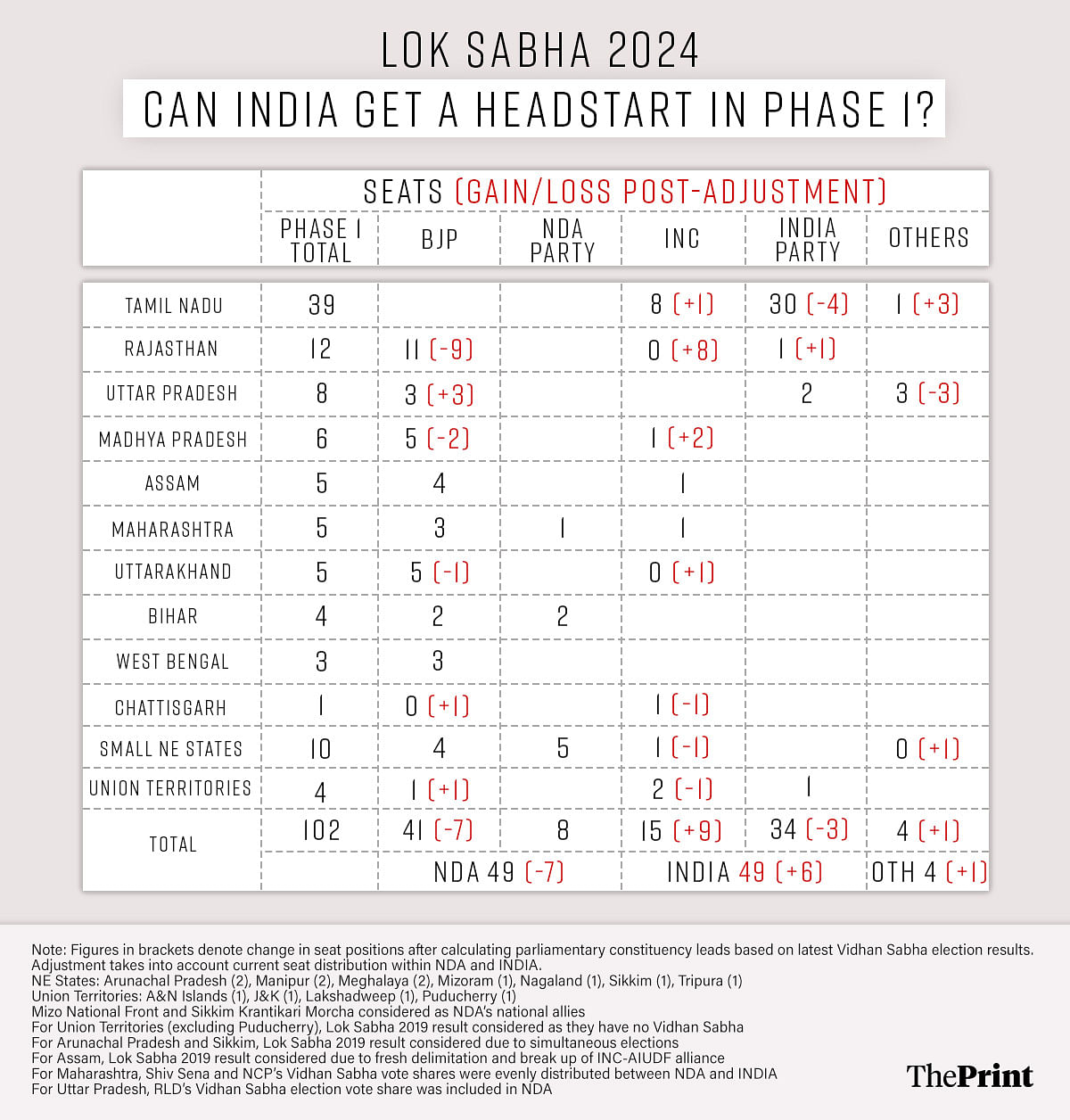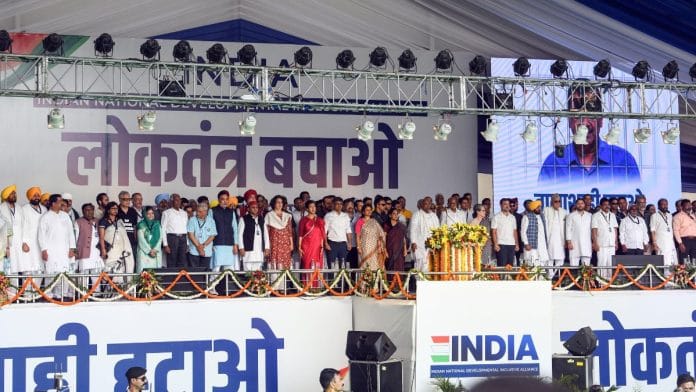The INDIA coalition can begin these elections with a much-needed headstart. The first and the largest of the seven phases of elections, involving nearly one-fifth of the country or 102 parliamentary constituencies, offers the Opposition an opportunity to build an early momentum, provided it can negotiate some serious challenges.
This opportunity arises from a coming together of three factors. First of all, it so happens that the NDA and INDIA were evenly matched in 2019 in the regions going to polls in the first phase. Going by the current political alignments, both NDA and INDIA secured 49 seats each in this phase last time. This parity is largely due to the presence of 39 Tamil Nadu seats in this lot. So, unlike all other phases where the NDA starts with a clear advantage, the election kicks off on an even footing.
Actually, the balance is tilted a bit in favour of INDIA if we look at the situation post-2019. The table accompanying this article considers the results of the latest Assembly elections in each state and converts these into parliamentary constituency leads (any losses or gains reported in parentheses). It shows that the INDIA bloc leads in 55 seats compared to 42 for the NDA. While INDIA partners have lost some ground in Tamil Nadu and Uttar Pradesh, they stand to gain as many as nine Lok Sabha seats in Rajasthan and two seats in Madhya Pradesh if we go by the latest Assembly elections data.

This is not just a statistical probability; there is a political opportunity in some regions that go to polls on the 19th. The northern and eastern belts of Rajasthan, with a significant presence of agrarian communities like Jat, Yadav, Gujjar and Meena, was the heart of the farmers’ movement in the state. This time, the Congress has managed to stitch an alliance with the Communist Party of India (Marxist) and the Rashtriya Loktantrik Party that can turn the tables on the Bhartiya Janata Party in this region, which can impact the second phase in the state too.
In Uttar Pradesh, the first phase comprises eight seats in the north-west. This region has a heavy presence of Muslim voters, and the Samajwadi Party does better here than its average in the state. This area was also affected by the farmers’ movement.
In Madhya Pradesh, the Mahakaushal region is one of the remaining strongholds of the Congress, as is the eastern Vidarbha area in Maharastra. These regions provide a good opportunity to the INDIA bloc, especially to the Congress, to halt a BJP sweep in the northern and western states.
Almost all the upper Assam seats and the three north Bengal seats that go to polls were won by the BJP last time, and it may not be easy to wrest these back. But if the Opposition is serious about taking on the BJP in these states, it must begin here. Almost all the seats of the hill states in the Northeast vote in this round (except one seat in Tripura and half a seat in Manipur, as part of Outer Manipur constituency votes in this phase and the remaining part in Phase 2), but it is difficult to see any dramatic turnaround in the dominance of the coalition that the BJP has forged in this region, notwithstanding the monumental tragedy in Manipur.
BJP’s denial of tickets to more than half of its sitting MPs in this phase opens another window of opportunity for INDIA. In Rajasthan, the BJP’s decision to drop nine out of its 11 MPs, has been met with rebellion and discontent. The INDIA alliance has played it safer by retaining 28 of its 49 MPs. It is only in Tamil Nadu that it has changed 18 of its 38 sitting candidates.
In sum if in Northern India, the INDIA bloc converts its post-2019 Assembly elections leads and in Southern India, it successfully defends the seats it won in 2019, it can potentially add 10-15 seats to its tally in this first phase.
But political opportunities do not come on a platter. Not in the face of the take-no-prisoner approach of Modi-Shah-led BJP. The INDIA coalition has to surmount many challenges in this first phase.
Also read: How BJP is using 2024 Lok Sabha election to lay groundwork for post-Modi succession plan
Challenges for INDIA
Retaining Tamil Nadu is INDIA’s first and foremost challenge in this phase. Dropping of many sitting MPs here, over and above the usual seat rotation, is an acknowledgement of this challenge. At this stage, the main rival remains the weakened and fragmented AIADMK and not the NDA. Notwithstanding the enormous energy invested by the BJP and the accompanying noise by the media, the NDA is still a weak coalition in the state. It is mainly the BJP and the Pattali Makkal Katchi, whose electoral strengths do not complement each other, with Dhinakaran and ex-CM O Paneerselvam coming in as individuals. The BJP’s campaign may help it raise its vote share significantly and be a force to reckon with in the long run, but it may not reach a threshold of converting its votes into seats this time. If anything, the triangular contest due to the break-up of the All India Anna Dravida Munnetra Kazhagam and the BJP alliance would help the INDIA bloc by splitting the anti-Dravida Munnetra Kazhagam vote and help it overcome the challenge of rising anti-incumbency.
Besides Tamil Nadu, the real challenge for INDIA remains the 45 seats where there’s a direct face-off between the Congress and the BJP. Out of these, 36 had witnessed a direct BJP-INC contest last time too. The result was 30-6 in BJP’s favour. If INDIA has to do well in this phase, then the Congress needs to fire all its engines, especially in states like Rajasthan, Madhya Pradesh, Maharashtra, Uttarakhand and Assam where it is primarily locked in direct fights with the BJP.
INDIA also needs to defend strongly the seats it won closely in 2019: in this phase, there are seven such seats which INDIA won with a margin of less than five percentage points; NDA has five such seats to defend and hence is, on this count, in a slightly more comfortable position.
The task for INDIA becomes difficult due to some internal and external challenges. In 14 of these seats, INDIA partners are contesting against one another. These include all three seats from West Bengal where Congress-Left alliance will cut into the Trinamool Congress’ votes, as well as three seats in Assam (TMC and AAP are spoilers here) and the lone seat of Lakshadweep, where the Congress is contesting against the incumbent MP of Nationalist Congress Party (Sharad Pawar).
Besides, some smaller parties outside the INDIA bloc can damage its potential. The Bahujan Samaj Party is contesting 86 seats in this phase, far more than the BJP or the Congress. Its vote share is shrinking with every election, but many of its candidates, especially in UP and Uttarakhand, are bound to hurt INDIA’s prospects. Prakash Ambedkar’s Vanchit Bahujan Aaghadi may not be as strong as it was in 2019, but it still has the potential to take away a slice of INDIA coalition’s votes in Vidarbha. Rashtriya Lok Dal president Jayant Singh’s decision to ally with the BJP has not gone down well with many of his Jat supporters and most of his Muslim voters, yet his switch is bound to reduce the potential of INDIA.
A visible lack of colour and buzz in the election so far suggests that the electoral temperature is highly subdued this time. Will this translate into lower turnout? In 2019, the turnout in these 102 constituencies stood at 69.9 per cent, two points higher than the national average. A lower-than-average turnout, especially in states outside Tamil Nadu, may indicate a wider pattern. The turnout figures for the first phase could be the first indication of the people’s mood in the 18th general election to the Lok Sabha.
Yogendra Yadav is National Convener of the Bharat Jodo Abhiyan. He tweets @_YogendraYadav. Shreyas Sardesai is a survey researcher associated with the Bharat Jodo Abhiyan. Rahul Shastri is a researcher. Views are personal.
(Edited by Theres Sudeep)







For articles like these, you expect us to donate The Print?? Have a few bipartisan articles or some counter view. Everyone knows what Duggal sahab is.
Job for likes of Yogendra Yadav is to create narrative in favor of INDI Alliance. What else can one expect?
Just do one thing, stop the elections and declare the unanimous vote to INDIA alliance.
Lol on one side Duggal Saab talks about how democracy is challenged and Modi as the dictator again writes up these advantage points. For him, Indian democracy is like Schrödingers cat.